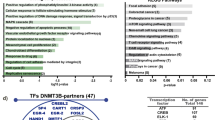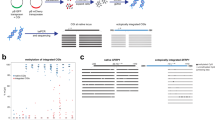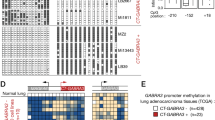Abstract
Silencing of gene expression by methylation of CpG islands in regulatory elements is frequently observed in cancer. However, an influence of the most common oncogenic signalling pathways onto DNA methylation has not yet been investigated thoroughly. To address this issue, we identified genes suppressed in HRAS-transformed rat fibroblasts but upregulated after treatment with the demethylating agent 5-Aza-2-deoxycytidine and with the MEK1,2 inhibitor U0126. Analysis of gene expression by microarray and Northern blot analysis revealed the MEK/ERK target genes clusterin, matrix metalloproteinase 2 (Mmp2), peptidylpropyl isomerase C-associated protein, syndecan 4, Timp2 and Thbs1 to be repressed in the HRAS-transformed FE-8 cells in a MEK/ERK- and methylation-dependent manner. Hypermethylation of putative regulatory elements in HRAS-transformed cells as compared to immortalized fibroblasts was detected within a CpG island 14.5 kb upstream of clusterin, within the clusterin promoter and within a CpG island of the Mmp2 promoter by bisulphite sequencing. Furthermore, hypermethylation of the clusterin promoter was observed 10 days after induction of HRAS in immortalized rat fibroblasts and a clear correlation between reduced clusterin expression and hypermethlyation could also be observed in distinct rat tissues. These results suggest that silencing of individual genes by DNA methylation is controlled by oncogenic signalling pathways, yet the mechanisms responsible for initial target gene suppression are variable.
This is a preview of subscription content, access via your institution
Access options
Subscribe to this journal
Receive 50 print issues and online access
$259.00 per year
only $5.18 per issue
Buy this article
- Purchase on Springer Link
- Instant access to full article PDF
Prices may be subject to local taxes which are calculated during checkout







Similar content being viewed by others
Abbreviations
- 5-Aza-CdR:
-
5-Aza-2-deoxycytidine
- Thbs1:
-
thrombospondin 1
- Mmp2:
-
matrix metalloproteinase 2
- Ppicap:
-
peptidylpropyl isomerase C-associated protein
- Thbs1:
-
thrombospondin 1
- Timp2:
-
tissue inhibitor of metalloproteinase 2
References
Avner P, Heard E . (2001). Nat Rev Genet 2: 59–67.
Baker KM, Wei G, Schaffner AE, Ostrowski MC . (2003). J Biol Chem 278: 17876–17884.
Bakin AV, Curran T . (1999). Science 283: 387–390.
Behrens P, Jeske W, Wernert N, Wellmann A . (2001). Pathobiology 69: 19–23.
Bergers G, Brekken R, McMahon G, Vu TH, Itoh T, Tamaki K et al. (2000). Nat Cell Biol 2: 737–744.
Bos JL . (1989). Cancer Res 49: 4682–4689.
Brazma A, Hingamp P, Quackenbush J, Sherlock G, Spellman P, Stoeckert C et al. (2001). Nat Genet 29: 365–371.
Brem R, Certa U, Neeb M, Nair AP, Moroni C . (2001). Oncogene 20: 2854–2858.
Brenner C, Deplus R, Didelot C, Loriot A, Vire E, De Smet C et al. (2005). EMBO J 24: 336–346.
Campbell SL, Khosravi-Far R, Rossman KL, Clark GJ, Der CJ . (1998). Oncogene 17: 1395–1413.
Cappabianca L, Farina AR, Tacconelli A, Mantovani R, Gulino A, Mackay AR . (2003). Exp Cell Res 286: 209–218.
Chen T, Turner J, McCarthy S, Scaltriti M, Bettuzzi S, Yeatman TJ . (2004). Cancer Res 64: 7412–7419.
Criswell TL, Beman M, Araki S, Leskov K, Cataldo E, Mayo LD et al. (2005). J Biol Chem 280: 14212–14221.
Deryugina EI, Luo GX, Reisfeld RA, Bourdon MA, Strongin A . (1997). Anticancer Res 17: 3201–3210.
Deryugina EI, Ratnikov B, Monosov E, Postnova TI, DiScipio R, Smith JW et al. (2001). Exp Cell Res 263: 209–223.
Di Croce L, Raker VA, Corsaro M, Fazi F, Fanelli M, Faretta M et al. (2002). Science 295: 1079–1082.
Downward J . (1998). Curr Op Genet Dev 8: 49–54.
Esteller M . (2002). Oncogene 21: 5427–5440.
Esteller M . (2003). Lancet Oncol 4: 351–358.
Esteller M, Corn PG, Baylin SB, Herman JG . (2001). Cancer Res 61: 3225–3229.
Fensterer H, Giehl K, Buchholz M, Ellenrieder V, Buck A, Kestler HA et al. (2004). Genes Chromosomes Cancer 39: 224–235.
Fuks F, Burgers WA, Brehm A, Hughes-Davies L, Kouzarides T . (2000). Nat Genet 24: 88–91.
Fuks F, Hurd PJ, Deplus R, Kouzarides T . (2003a). Nucleic Acids Res 31: 2305–2312.
Fuks F, Hurd PJ, Wolf D, Nan X, Bird AP, Kouzarides T . (2003b). J Biol Chem 278: 4035–4040.
Gadal F, Bozic C, Pillot-Brochet C, Malinge S, Wagner S, Le Cam A et al. (2003). Nucleic Acids Res 31: 5789–5804.
Griegel S, Traub O, Willecke K, Schäfer R . (1986). Int J Cancer 38: 697–705.
Hsieh CL . (1994). Mol Cell Biol 14: 5487–5494.
Issa JP, Vertino PM, Wu J, Sazawal S, Celano P, Nelkin BD et al. (1993). J Natl Cancer Inst 85: 1235–1240.
Itoh T, Tanioka M, Yoshida H, Yoshioka T, Nishimoto H, Itohara S . (1998). Cancer Res 58: 1048–1051.
Ivanova T, Vinokurova S, Petrenko A, Eshilev E, Solovyova N, Kisseljov F et al. (2004). Int J Cancer 108: 882–886.
Jones SE, Jomary C . (2002). Int J Biochem Cell Biol 34: 427–431.
Kautiainen TL, Jones PA . (1986). J Biol Chem 261: 1594–1598.
Klock G, Storch S, Rickert J, Gutacker C, Koch-Brandt C . (1998). J Cell Physiol 177: 593–605.
Kyprianou N, English HF, Davidson NE, Isaacs JT . (1991). Cancer Res 51: 162–166.
Lachner M, Jenuwein T . (2002). Curr Opin Cell Biol 14: 286–298.
Laduron S, Deplus R, Zhou S, Kholmanskikh O, Godelaine D, De Smet C et al. (2004). Nucleic Acids Res 32: 4340–4350.
Leskov KS, Klokov DY, Li J, Kinsella TJ, Boothman DA . (2003). J Biol Chem 278: 11590–11600.
Li LC, Dahiya R . (2002). Bioinformatics 18: 1427–1431.
Li Q, Ahuja N, Burger PC, Issa JP . (1999). Oncogene 18: 3284–3289.
Liu HS, Scrable H, Villaret DB, Lieberman MA, Stambrook PJ . (1992). Cancer Res 52: 983–989.
Lopes S, Lewis A, Hajkova P, Dean W, Oswald J, Forne T et al. (2003). Hum Mol Genet 12: 295–305.
Lymar ES, Clark AM, Reeves R, Griswold MD . (2000). Biol Reprod 63: 1341–1351.
Mansour SJ, Matten WT, Hermann AS, Candia JM, Rong S, Fukasawa K et al. (1994). Science 265: 966–970.
Olek A, Oswald J, Walter J . (1996). Nucleic Acids Res 24: 5064–5066.
Ordway JM, Williams K, Curran T . (2004). Oncogene 23: 3737–3748.
Pucci S, Bonanno E, Pichiorri F, Angeloni C, Spagnoli LG . (2004). Oncogene 23: 2298–2304.
Raudies O, Kuban RJ, Hamacher F, Klein-Hitpass L, Tchernitsa OI, Sers C et al. (2005). Adv Enzyme Regul 45: 63–84.
Reik W, Walter J . (2001). Nat Rev Genet 2: 21–32.
Reik W, Dean W, Walter J . (2001). Science 293: 1089–1093.
Rosemblit N, Chen CL . (1994). J Mol Endocrinol 13: 69–76.
Rouleau J, Macleod AR, Szyf M . (1995). J Biol Chem 270: 1595–1601.
Scaltriti M, Brausi M, Amorosi A, Caporali A, D'Arca D, Astancolle S et al. (2004a). Int J Cancer 108: 23–30.
Scaltriti M, Santamaria A, Paciucci R, Bettuzzi S . (2004b). Cancer Res 64: 6174–6182.
Schäfer R, Iyer J, Iten E, Nirkko AC . (1988). Proc Natl Acad Soc USA 85: 1590–1594.
Schneider-Stock R, Dias-Assef M, Rohrbeck A, Foltzer-Jourdainne C, Boltze C, Hartig R et al. (2005). J Pharmacol Exp Ther 312: 525–536.
Schwarte-Waldhoff I, Martin W, Willecke K, Schäfer R . (1994). Oncogene 9: 899–909.
Sers C, Tchernitsa OI, Zuber J, Diatchenko L, Zhumabayeva B, Desai S et al. (2002). Adv Enzyme Regul 42: 63–82.
Takai D, Jones PA . (2002). Proc Natl Acad Sci USA 99: 3740–3745.
Taraboletti G, Morbidelli L, Donnini S, Parenti A, Granger HJ, Giavazzi R et al. (2000). FASEB J 14: 1674–1676.
Tchernitsa OI, Sers C, Zuber J, Hinzmann B, Grips M, Schwendel A et al. (2004). Oncogene 23: 4536–4555.
Villar-Garea A, Esteller M . (2004). Int J Cancer 112: 171–178.
Wang Z, Juttermann R, Soloway PD . (2000). J Biol Chem 275: 26411–26415.
Watnick RS, Cheng YN, Rangarajan A, Ince TA, Weinberg RA . (2003). Cancer Cell 3: 219–231.
Wei G, Schaffner AE, Baker KM, Mansky KC, Ostrowski MC . (2003). Anticancer Res 23: 2173–2178.
Wolthuis RM, Bos JL . (1999). Curr Opin Genet Dev 9: 112–117.
Zhou X, Richon VM, Wang AH, Yang XJ, Rifkind RA, Marks PA . (2000). Proc Natl Acad Sci USA 97: 14329–14333.
Zohn IM, Campbell SL, Khosravi-Far R, Rossman KL, Der CJ . (1998). Oncogene 17: 1415–1438.
Zuber J, Tchernitsa OI, Hinzmann B, Schmitz AC, Grips M, Hellriegel M et al. (2000). Nat Genet 24: 144–152.
Acknowledgements
We thank Conny Giesseler, Katrin Kremp, Kerstin Lehmann, Kristin Lucht and Christina Daniel for technical assistance and Karsten Juerchott for helpful discussion. We are grateful to Pablo Steinberg (German Institute of Human Nutrition, Potsdam-Rehbrücke), who provided us with samples from rat colon and small intestine. This work was supported by grants from the Deutsche Forschungsgemeinschaft (SFB618 grant to RS and HpH) and the Stifterverband für die Deutsche Wissenschaft (grant to CS, RS, JW and HpH).
Author information
Authors and Affiliations
Corresponding author
Additional information
Supplementary Information accompanies the paper on Oncogene website (http://www.nature.com/onc).
Supplementary information
Rights and permissions
About this article
Cite this article
Lund, P., Weißhaupt, K., Mikeska, T. et al. Oncogenic HRAS suppresses clusterin expression through promoter hypermethylation. Oncogene 25, 4890–4903 (2006). https://doi.org/10.1038/sj.onc.1209502
Received:
Revised:
Accepted:
Published:
Issue Date:
DOI: https://doi.org/10.1038/sj.onc.1209502
Keywords
This article is cited by
-
Transforming growth factor-β1 decreases erythropoietin production through repressing hypoxia-inducible factor 2α in erythropoietin-producing cells
Journal of Biomedical Science (2021)
-
Air pollution-induced epigenetic changes: disease development and a possible link with hypersensitivity pneumonitis
Environmental Science and Pollution Research (2021)
-
An immortalized cell line derived from renal erythropoietin-producing (REP) cells demonstrates their potential to transform into myofibroblasts
Scientific Reports (2019)
-
The effects of dietary polyunsaturated fatty acids on miR-126 promoter DNA methylation status and VEGF protein expression in the colorectal cancer cells
Genes & Nutrition (2018)
-
Epigenetic and immunohistochemical characterization of the Clusterin gene in ovarian tumors
Archives of Gynecology and Obstetrics (2013)



